Epilators, like waxing, pull out the whole hair from the root allowing for weeks of smooth, hair-free skin. There are two categories of hair removal: epilation and depilation. Depilation describes hair removal options from above the skin like shaving and hair removal creams. Epilation includes methods like sugaring, waxing, threading and, of course, – epilating. In this article, there is plenty of information on how to use an epilator and why you should give epilating a try.
In this article:
- What Is an Epilator?
- Epilator vs. Waxing vs. Shaving
- What Are the Epilator Benefits?
- Are There Any Risks to Using an Epilator?
- How Do I Use an Epilator Effectively?
- How Often and When Should I Use an Epilator?
- Does Epilating Hurt?
- Other Useful Epilator Tips
What Is an Epilator and How Does It Work?
An epilator is an electric device that removes body hair. The basic design utilizes dozens of mini tweezers to pull body hair out by the root in a quick and efficient manner. The tweezers are on a rotating head that swoops over the surface of your skin, allowing the tweezers to grab and pull the hair out by the root in a quick smooth motion.
If this sounds scary or painful just remember that technically, removing body hair can take some getting used to, and the quicker and more efficiently it is done, the easier it is to get used to. Furthermore, this method offers longer-lasting hair removal than shaving does.
The first epilator was created in Israel in the 1980s but suffered a design flaw. The first model used a spring to grab and pull out the hairs, but the constant flexing of the coil led to a limited shelf life.
The next generation of epilator was considered too similar to the first and was subjected to litigation. After successfully beating the case, this version birthed the next generations, which led to our current long-lasting, handheld option today.
If you are on the fence about using an epilator, keep reading, we can help you decide!

Epilator vs. Waxing vs. Shaving
Epilating, waxing and shaving are the most common hair removal methods, but which one is more effective and what are the differences between them?
Let’s break this section down into categories to see how they really pair off.
- Ease of Use: The easiest option to use would likely be waxing. Essentially, wax is applied to the area where you want the hair removed, then ripped off, pulling the hair with it. There are several types of wax that can be used, and you don’t even have to do the waxing yourself! With epilating you have to hold the epilator in the right position, which can change depending on where you are using it.
- Cost: The most cost-effective method of hair removal is definitely epilating.
- Pain: Unless you cut yourself, shaving is the least painful option of the three. This is, of course, dependent on the severity of the cut, but even still, against the initial experience of waxing or epilating, shaving isn’t a pain at all.
- Results: All three methods of hair removal work, though shaving works the least in comparison with epilating and waxing.
Zooming on in Epilators
Epilators are small, handheld devices that utilize multiple sets of tweezers on a roller to pull hair out by the root. Rather than tweezing a single hair at a time, hair is removed en masse with each pass.
Epilators can still remove very short hairs from the root, meaning you don’t have to wait for your hair to be an uncomfortable length before effectively removing it. With each use, over time, you’re likely to see that your hair is taking longer to grow back and when it does it grows back finer and softer.
Many epilators come with interchangeable heads, one for the face, one for the body, etc. Some versions are waterproof, wireless and rechargeable.
Using an epilator means incurring an upfront cost – fortunately, they are relatively inexpensive, even the more expensive ones. Once purchased, with upkeep you are only paying for the electricity to power it. This makes epilators much less expensive overall than their hair removal counterparts.

Zooming on in Waxing
Waxing is done by applying (typically warm or hot) wax to your skin following the direction of your hair growth. Infamously, the wax is then quickly removed. Let’s be real, the wax is snatched off your skin in the opposite direction of your hair growth, taking the hair along with it, pulled from the roots.
Waxing produces long-lasting results and over time it is possible to notice that your hair grows back softer and finer with a longer window of results between waxes. Unfortunately, your hair needs to grow back to a certain length for waxing to be most effective, and very short hairs can be a problem for the wax to hold on to.
Waxing can range in prices but is relatively inexpensive depending on how much hair you want to be removed. If you choose to wax at home, your costs will include purchasing supplies, be it wax strips, cold wax, warm wax, applicators, etc. If you are doing the waxing yourself, the cost compared to shaving is actually less in the long run.
Zooming on in Shaving
Shaving is gliding a razor over your skin in the opposite direction that your hair is growing. The blade will remove the portion of the hair that sits above the level of your skin. Your skin will feel smooth and hair-free, but for the shortest time of the three hair removal options.
Depending on how quickly your hair grows, you may have to repeat the process within 24 to 48 hours in order to keep seeing these results. People often report that the stubble (which is your hair growing back) feels coarser and thicker than the hair that was initially removed, spawning the old wives’ tale that shaving makes your hair grow back thicker and faster.
Razors for women range in cost and wear out quickly. Even though cheaper razors are relatively cheap, the more often you have to shave, the quicker your razor wears out, building up costs quickly as well.

What Are the Epilator Benefits?
An epilator has a lot of benefits, especially over other hair removal methods.
- For starters, epilating is cheaper and more convenient. You can epilate without any tools besides the epilator.
- You will definitely be able to experience longer periods of smooth, hair-free skin.
- Epilators can grab hairs much shorter than waxing can, meaning that you don’t have to deal with waiting for your hair to regrow to a longer length before you can wax again. You can effectively epilate hair that is 0.02 inches long rather than waiting for it to grow to a length of nearly an inch long (0.08 inches) before waxing becomes an option.
- As you continue to use your epilator, the hair will take longer and longer to regrow. Additionally, you will see that the hair, when it does grow back, is softer and thinner than before.
Are There Any Risks to Using an Epilator?
Risks with an epilator are minimal and largely attributed to improper technique. As you use your epilator, your technique will improve and solidify.
The improper technique would mean going too fast or moving the epilator against the natural direction your hair grows in. Doing either of these things may result in you breaking the hair shaft rather than pulling it out from the root. Shorter, broken hairs are more likely to become ingrown, and ingrown hairs can also become infected.
How Do I Use an Epilator Effectively?
This is how you should use an epilator to remove unwanted hair:
- Take a Shower
Take a warm shower and thoroughly wash to eliminate any body oils, lotions or moisturizers that might make it hard for the epilator to grab the hair. After washing, exfoliate your skin lightly, paying attention to the areas you’ll be removing hair from.
- Know Your Epilator Features
Check to see if your epilator can be used in the shower. If so, you don’t need to dry off afterwards, but if you are using your epilator dry, you’ll want to pat your skin dry. You’ll need to epilate prior to applying any lotions or body creams.
- Master the Technique
Pull the skin of the area you want to epilate taut, especially in your more sensitive and fleshier areas.
Effective use of an epilator means holding the device at a 90-degree angle on the skin to allow the tweezers to get a good, firm and quick grip on the hair as the roller turns. - Work in the Opposite Direction of Hair Growth
Turn on your epilator and move it across your skin in the opposite direction of your hair growth. Your hair growth direction will likely change directions in different areas so it is important to pay attention. Areas like your underarm have hair growing in multiple directions, so you may need to go over these sections with a few passes, keeping your epilator in light contact with your skin. You don’t need to push down.
- Moisturize
Once you’re finished, apply a soothing, unscented moisturizer or lotion to your skin.
Aftercare Instructions
Avoid tight-fitting clothing in sensitive areas for a few days and exfoliate every few days as well to avoid any ingrown hairs. Initially, your skin may be sensitive, but this will pass quickly. Try not to use any pore-blocking oils or heavily scented creams.

How Often and When Should I Use an Epilator?
You can use your epilator as soon as your hair has grown to a length of 0.02 inches, which is 0.5 millimeters. A half a millimeter of regrowth will take 6 weeks or more to grow in general cases, meaning that you can enjoy approximately a month and a half without having to worry about hair removal.
If you have bought a rechargeable wet & dry epilator, then you can even use the device in the shower. These are arguably the best epilators because they can be used in or out of the tub, and even on the go should the need like travelling arise.
A dry only or plugged-in epilator is best used post shower when the skin is completely dried.
Does Epilating Hurt?
I’ll keep this answer short and clear: yes. Epilating hurts initially, but just like waxing, tweezing your eyebrows and sugaring, you get used to it quickly and it is a longer-term option for smooth skin.
Truthfully, there are ways to make it hurt less. Warm baths or showers can help, and using a waterproof epilator destined for in-shower use can also be helpful. If you don’t mind spending a longer time removing the unwanted hair, you can use your epilator at a lower speed to reduce some of the discomfort.
The discomfort does ease with continued use, so you can give yourself a less painful start by using your epilator for the first time on the regrowth from your last waxing appointment. There will be less hair and it will be finer. This will translate to less discomfort on your first use.
Other Useful Epilator Tips to Know
So, there are a few other tips and tricks that can help make using your epilator more enjoyable.
- Most epilators have different speed settings, so it’s best to start using your epilator on the lowest setting first, building up to your personal tolerance and technique.
- To avoid missing hair, go slowly at first and even when your technique is comfortable and efficient, remember not to rush.
- Clean your epilator after each use. Most include a little brush to help brush out any hairs, but you should also use alcohol. This will limit the likelihood of any resulting ingrown hairs developing folliculitis.
- Use a moisturizer rather than a heavy cream or lotion to soothe your skin after epilating.
- There may be some redness or even dots of irritation showing up on the skin after you epilate, but these will go away in a few hours max. Because of the irritation, it is better to epilate in the evenings. When you wake up, there will be no more irritation or redness.
Photos via @donnaromina, Instagram





